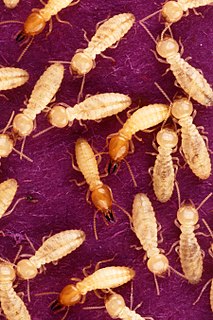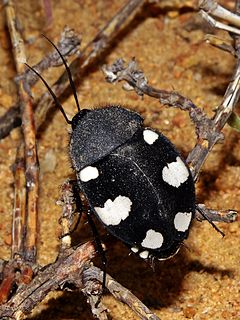Related Research Articles

Lynn Margulis was an American evolutionary biologist, and was the primary modern proponent for the significance of symbiosis in evolution. Historian Jan Sapp has said that "Lynn Margulis's name is as synonymous with symbiosis as Charles Darwin's is with evolution." In particular, Margulis transformed and fundamentally framed current understanding of the evolution of cells with nuclei – an event Ernst Mayr called "perhaps the most important and dramatic event in the history of life" – by proposing it to have been the result of symbiotic mergers of bacteria. Margulis was also the co-developer of the Gaia hypothesis with the British chemist James Lovelock, proposing that the Earth functions as a single self-regulating system, and was the principal defender and promulgator of the five kingdom classification of Robert Whittaker.

Termites are eusocial insects that are classified at the taxonomic rank of infraorder Isoptera, or alternatively as epifamily Termitoidae, within the order Blattodea. Termites were once classified in a separate order from cockroaches, but recent phylogenetic studies indicate that they evolved from cockroaches, as they are deeply nested within the group, and the sister group to wood eating cockroaches of the genus Cryptocercus. Previous estimates suggested the divergence took place during the Jurassic or Triassic. More recent estimates suggest that they have an origin during the Late Jurassic, with the first fossil records in the Early Cretaceous. About 3,106 species are currently described, with a few hundred more left to be described. Although these insects are often called "white ants", they are not ants, and are not closely related to ants.

A spirochaete or spirochete is a member of the phylum Spirochaetota, which contains distinctive diderm (double-membrane) gram-negative bacteria, most of which have long, helically coiled cells. Spirochaetes are chemoheterotrophic in nature, with lengths between 3 and 500 μm and diameters around 0.09 to at least 3 μm.

Blattodea is an order of insects that contains cockroaches and termites. Formerly, the termites were considered a separate order, Isoptera, but genetic and molecular evidence suggests termites evolved from within the cockroach lineage, cladistically making them cockroaches as well. The Blattodea and the mantises are now all considered part of the superorder Dictyoptera. Blattodea includes approximately 4,400 species of cockroach in almost 500 genera, and about 3,000 species of termite in around 300 genera.
Fibrobacterota is a small bacterial phylum which includes many of the major rumen bacteria, allowing for the degradation of plant-based cellulose in ruminant animals. Members of this phylum were categorized in other phyla. The genus Fibrobacter was removed from the genus Bacteroides in 1988.

Ensifer is a genus of nitrogen-fixing bacteria (rhizobia), three of which have been sequenced.
In taxonomy, Ahrensia is a genus of the Hyphomicrobiales. Ahrensia is named after the German microbiologist R. Ahrens. The cells are rod-shaped and motile. They are strictly aerobic.
In taxonomy, Stappia is a genus of the Hyphomicrobiales. Some members of the genus oxidize carbon monoxide (CO) aerobically. Stappia indica is a diatom associated bacterium which is known to inhibit the growth of diatoms such as Thalassiosira pseudonana.
In taxonomy, Methanosaeta is a genus of microbes within Methanosaetaceae. Like other species in this family, those of Methanosaeta metabolize acetate as their sole source of energy. The genus contains two species, Methanosaeta concilii, which is the type species and Methanosaeta thermophila. For a time, some scientists believed there to be a third species, Methanosaeta soehngenii, but because it has not been described from a pure culture, it is now called Methanothrix soehngenii.

In taxonomy, Methanohalophilus is a genus of the Methanosarcinaceae.
Blattabacterium is a genus of obligate mutualistic endosymbiont bacteria that are believed to inhabit all species of cockroach studied to date, with the exception of the genus Nocticola. The genus' presence in the termite Mastotermes darwiniensis led to speculation, later confirmed, that termites and cockroaches are evolutionarily linked.

Bacterial phyla constitute the major lineages of the domain Bacteria. While the exact definition of a bacterial phylum is debated, a popular definition is that a bacterial phylum is a monophyletic lineage of bacteria whose 16S rRNA genes share a pairwise sequence identity of ~75% or less with those of the members of other bacterial phyla.
Paul De Vos is a Belgian microbiologist. He is an emeritus professor of the University of Ghent, where he was also head of the biochemistry and microbiology department. He was editor of Bergey's Manual of Systematic Bacteriology, Volume 3: The Firmicutes, published in 2009.
Flavobacterium xanthum is a species of bacteria.
Diplocalyx is a genus of bacteria of the spirochete phylum. The genus was originally established in 1968 on the basis of differential morphology when compared to other spirochete species. No species within it has been successfully grown in culture. Up to now there is only on species of this genus known.
Pillotina calotermitidis is a species of spirochete that is symbiotic in wood-eating cockroaches and termites, the type species of its genus.
Clevelandina reticulitermitidis is a species of spirochete that is symbiotic in wood-eating cockroaches and termites, the type species of its genus.
Cryobacterium psychrophilum is the type species of the bacterial genus Cryobacterium. It is an obligately psychrophilic, Gram-positive irregular rod-shaped actinomycete.
Cryobacterium is a Gram-positive and strictly aerobic bacterial genus from the family of Microbacteriaceae.
Hallella is a Gram-negative, non-spore-forming, anaerobic and non-motile genus of bacteria from the family of Prevotellaceae with on known species. Hallella is named after the American microbiologist Ivan C. Hall. Hallella seregens has been isolated from a gingival crevice of a patient.
References
- ↑ Bermudes, D.; Chase, D.; Margulis, L. (1988). "Morphology as a Basis for Taxonomy of Large Spirochetes Symbiotic in Wood-Eating Cockroaches and Termites: Pillotina gen. nov., nom. rev.; Pillotina calotermitidis sp. nov., nom. rev.; Diplocalyx gen. nov., nom. rev.; Diplocalyx calotermitidis sp. nov., nom. rev.; Hollandina gen. nov., nom. rev.; Hollandina pterotermitidis sp. nov., nom. rev.; and Clevelandina reticulitermitidis gen. nov., sp. nov". International Journal of Systematic Bacteriology. 38 (3): 291–302. doi: 10.1099/00207713-38-3-291 . ISSN 0020-7713. PMID 11542253.